The Project
The Team
The Locations
Daily Journal
Contact Us
R/V Wecoma Daily Report
R/V Wecoma Cruise Track
Links
Glossary

|
Daily Journal
Vocabulary words to look for:
bacteria:
The simplest structural form of life without a nucleus.
biomass:
The living weight of organisms.
bloom:
A sudden increase in the number of phytoplankton, often following a flood of nutrients from changing ocean currents, heavy rains, or a string of sunny days.
metabolic:
All the biochemical processes continuously going on in living organisms.
carbon dioxide:
The waste product of respiration, a colorless, odorless gas. A major greenhouse gas that contributes to global warming.
grazing:
Eating, usually refers to plant eaters (herbivores).
phytoplankton:
Tiny photosynthetic organisms that float on and near the surface of the ocean and provide food for other organisms.
protist:
Primarily consists of single-celled microorganisms, some are multicellular but do not have specialized cells. Each cell has the same structure and function. |
September 21, 2004:
Barry and Ev Sherr
Meet Ev, Barry, and their son, Jared
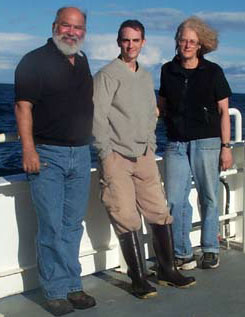
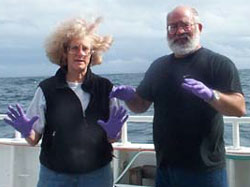
The Sherrs have been working as biological oceanographers at OSU for 15
years. The have been enchanted by the sea their entire lives and have been
working in this field for thirty-five years. They have two sons, Jared,
who is also on this cruise, and Aaron. They tell us they have a home in
Corvallis, but we think their true home is out here on the ocean. They delight in watching the sunsets at sea, and Ev is an expert at seeing the green flash as the sun sets.
Ev was greatly influenced to go into this field when she saw a National
Science Foundation film on oceanography. She grew up in Daytona Beach,
Florida, and has always felt at home near the sea. Barry spent happy
childhood summers at Coney Island, New York, and loved to read books by
Jaques Cousteau.
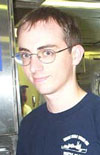 Ev said she feels fortunate to have a career they both really enjoy. She
said they love their work, and find it to be fascinating and exciting.
Their enthusiasm is contagious. She and Barry job share at OSU. Their
son Jared is here for his first cruise. He came along to see what his
folks were up to and probably is eating better out here than if he and his
brother stayed home alone. He said that he probably will not become an
oceanographer and that he is interested in the study of physics. With
parents like his, we are certain he'll be terrific at whatever he chooses. Ev said she feels fortunate to have a career they both really enjoy. She
said they love their work, and find it to be fascinating and exciting.
Their enthusiasm is contagious. She and Barry job share at OSU. Their
son Jared is here for his first cruise. He came along to see what his
folks were up to and probably is eating better out here than if he and his
brother stayed home alone. He said that he probably will not become an
oceanographer and that he is interested in the study of physics. With
parents like his, we are certain he'll be terrific at whatever he chooses.
Ev and Barry are the two PIs (Principal Investigators) on this
cruise. Their research objectives deal with the activity of bacteria and
their role in the ocean, as well as the effects of trace metals on
microplankton. Even though they cannot be seen by the naked eye, bacteria
make up the largest biomass of living organisms on the planet. They have a very high metabolic rate, so they grow quickly and they process (or eat) a great deal of material in the sea.
The great cycle of life begins with bacteria that most of us will never
see. Their health, well being, and survival have a huge impact on the
ecosystem of the planet.
Bacterial activity is closely tied to temperature. As temperature
increases metabolic activity rises. The little guys (bacteria) then
respire (breathe) in oxygen and give off carbon dioxide. Carbon dioxide
and oxygen balance in the ocean and the atmosphere is very important.
Bacteria are vital to the food web because they are a food source for
other microorganisms, called protists. These protists (single celled
organisms) eat bacteria. The scientists are interested in what the
bacteria eat, at what rate they are eaten by protists, and what effect all
this has on the food web.
Protists are the second most important biomass in the ocean. The
relationship between the bacteria and the protists is of great importance
because who is grazing whom affects diversity in the food chain. Change
can occur quickly. The global changes occuring worldwide may change the
ocean's food web.
You may have heard about "dead zones" in the news. They are areas of
coastal waters where the oxygen level is too low to support life. Dead
zones occur periodically off the Oregon coast when changes in the ocean
currents bring in extra nutrients, allowing phytoplankton to grow to a
high density. These organisms form a huge biomass, and then sink to the
bottom of the ocean. Our friends, the bacteria, consume the phytoplankton.
The bacteria feast and gorge themselves and as they do they take in the
oxygen needed by other life forms in the ocean and give off carbon dioxide
which creates the dead zone. Some other dead zones are caused by human
activity. One of the worst is in the Gulf of Mexico where the Mississippi
River flows into the sea, which is caused by agricultural runoff. The
nutrients washed down the river promote the growth of phytoplanktonm,
causing a bloom similar to the situation above.
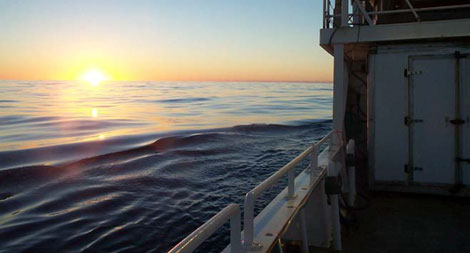
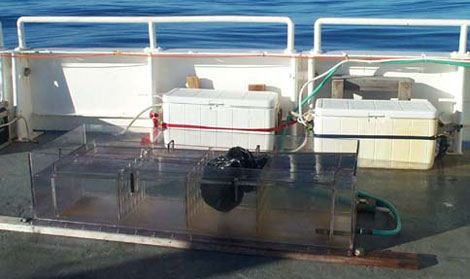
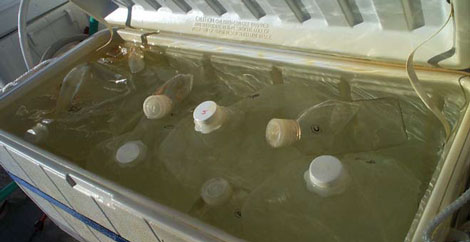
Top: Ev's sunset, watching for the "green flash"
Middle: Ev and Barry's bathtub for preserving water samples
Bottom: Water, water everywhere
Back to Daily Journals

|







